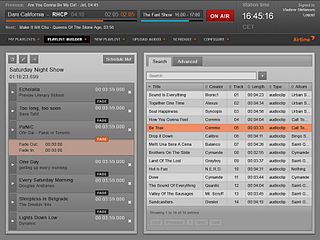 W
WAirtime is a radio management application for remote broadcast automation, and program exchange between radio stations. Airtime is being developed and released as free and open-source software, subject to the requirements of the GNU General Public License (GPL), version 3 or any later.
 W
WAn antenna tuning hut or helix house is a small shed at the base of a longwave or mediumwave radio transmitting antenna. It contains antenna tuner radio equipment for coupling the power from the feedline to the antenna. The building may also contain lightning protection devices and power transformers for aircraft warning light on the tower. The radio transmitter which generates the radio frequency current which powers the antenna is generally located away from the antenna, to prevent the powerful radio waves from interfering with the sensitive transmitter circuits. The radio frequency current from the transmitter is supplied to the antenna through a cable called the feedline. The antenna tuning hut contains a matching network consisting of capacitors and inductors (coils) needed to match the antenna's impedance with the feedline, so power is transferred efficiently to the antenna. The inductors, consisting of large helixes of wire, give it the common name helix house.
 W
WAutomatic gain control (AGC), is a closed-loop feedback regulating circuit in an amplifier or chain of amplifiers, the purpose of which is to maintain a suitable signal amplitude at its output, despite variation of the signal amplitude at the input. The average or peak output signal level is used to dynamically adjust the gain of the amplifiers, enabling the circuit to work satisfactorily with a greater range of input signal levels. It is used in most radio receivers to equalize the average volume (loudness) of different radio stations due to differences in received signal strength, as well as variations in a single station's radio signal due to fading. Without AGC the sound emitted from an AM radio receiver would vary to an extreme extent from a weak to a strong signal; the AGC effectively reduces the volume if the signal is strong and raises it when it is weaker. In a typical receiver the AGC feedback control signal is usually taken from the detector stage and applied to control the gain of the IF or RF amplifier stages.
 W
WBBC Research & Development is the technical research department of the BBC.
 W
WA block upconverter (BUC) is used in the transmission (uplink) of satellite signals. It converts a band of frequencies from a lower frequency to a higher frequency. Modern BUCs convert from the L band to Ku band, C band and Ka band. Older BUCs convert from a 70 MHz intermediate frequency (IF) to Ku band or C band.
 W
WA cable grommet is a tube or ring through which an electrical cable passes. They are usually made of rubber or metal.
 W
WCampcaster is a free and open source radio management application for live broadcasting, remote broadcast automation, and program exchange between radio stations. Campcaster was designed to allow implementation in a number of use scenarios, ranging from an unmanned broadcast unit accessed from remote through the Internet to a local network of Campcaster machines inside a radio station handling live broadcasts and delivering program automation by accessing a central audio storage system.
 W
WAn ionosonde, or chirpsounder, is a special radar for the examination of the ionosphere. The basic ionosonde technology was invented in 1925 by Gregory Breit and Merle A. Tuve and further developed in the late 1920s by a number of prominent physicists, including Edward Victor Appleton. The term ionosphere and hence, the etymology of its derivatives, was proposed by Robert Watson-Watt.
 W
WA circulator is a passive, non-reciprocal three- or four-port device, in which a microwave or radio-frequency signal entering any port is transmitted to the next port in rotation (only). A port in this context is a point where an external waveguide or transmission line, connects to the device. For a three-port circulator, a signal applied to port 1 only comes out of port 2; a signal applied to port 2 only comes out of port 3; a signal applied to port 3 only comes out of port 1, so to up to a phase-factor, the scattering matrix for an ideal three-port circulator is
 W
WA radio clock or radio-controlled clock (RCC) is a type of quartz clock or watch that is automatically synchronized to a time code transmitted by a radio transmitter connected to a time standard such as an atomic clock. Such a clock may be synchronized to the time sent by a single transmitter, such as many national or regional time transmitters, or may use the multiple transmitters used by satellite navigation systems such as GPS. Such systems may be used to automatically set clocks or for any purpose where accurate time is needed. RC clocks may include any feature available for a clock, such as alarm function, display of ambient temperature and humidity, broadcast radio reception, etc.
 W
WThe Common Public Radio Interface (CPRI) standard defines an interface between Radio Equipment Control (REC) and Radio Equipment (RE). Oftentimes, CPRI links are used to carry data between cell sites and base stations.
 W
WIn radio and telecommunications a dipole antenna or doublet is the simplest and most widely used class of antenna. The dipole is any one of a class of antennas producing a radiation pattern approximating that of an elementary electric dipole with a radiating structure supporting a line current so energized that the current has only one node at each end. A dipole antenna commonly consists of two identical conductive elements such as metal wires or rods. The driving current from the transmitter is applied, or for receiving antennas the output signal to the receiver is taken, between the two halves of the antenna. Each side of the feedline to the transmitter or receiver is connected to one of the conductors. This contrasts with a monopole antenna, which consists of a single rod or conductor with one side of the feedline connected to it, and the other side connected to some type of ground. A common example of a dipole is the "rabbit ears" television antenna found on broadcast television sets.
 W
WEF Johnson Technologies, Inc. is a two-way radio manufacturer founded by its namesake, Edgar. F. Johnson, in Waseca, Minnesota, United States in 1923. Today it is a wholly owned subsidiary of JVCKenwood of Yokohama, Japan.
 W
WThe Family Radio Service (FRS) is an improved walkie-talkie radio system authorized in the United States since 1996. This personal radio service uses channelized frequencies around 462 and 467 MHz in the ultra high frequency (UHF) band. It does not suffer the interference effects found on citizens' band (CB) at 27 MHz, or the 49 MHz band also used by cordless telephones, toys, and baby monitors. FRS uses frequency modulation (FM) instead of amplitude modulation (AM). Since the UHF band has different radio propagation characteristics, short-range use of FRS may be more predictable than the more powerful license-free radios operating in the HF CB band.
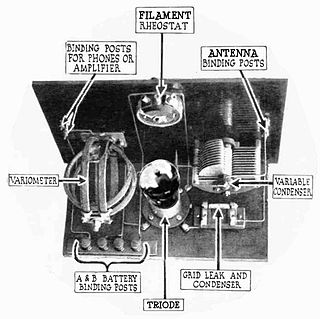 W
WA grid leak detector is an electronic circuit that demodulates an amplitude modulated alternating current and amplifies the recovered modulating voltage. The circuit utilizes the non-linear cathode to control grid conduction characteristic and the amplification factor of a vacuum tube. Invented by Lee De Forest around 1912, it was used as the detector (demodulator) in the first vacuum tube radio receivers until the 1930s.
 W
WThe Kitzbüheler Horn Transmitter is a 102-metre-high (335 ft) transmission tower made of reinforced concrete on the summit of the Kitzbüheler Horn near Kitzbühel in Austria. The Kitzbühler Horn Transmitter does not have a cylindrical shaft. It broadcasts TV and VHF radio programmes. The tower was taken into service on 12 December 1969 as a combined radio and television transmission facility for the ORF after a difficult two-year-long construction period. This had been preceded by lengthy and intensive negotiations with local authorities and land owners.
 W
WLow-power broadcasting is broadcasting by a broadcast station at a low electric power to a smaller service area than "full power" stations within the same region. It is often distinguished from "micropower broadcasting" and broadcast translators. LPAM, LPFM and LPTV are in various levels of use across the world, varying widely based on the laws and their enforcement.
 W
WMicrophonics, microphony, or microphonism describes the phenomenon wherein certain components in electronic devices transform mechanical vibrations into an undesired electrical signal (noise). The term comes from analogy with a microphone, which is intentionally designed to convert vibrations to electrical signals.
 W
WMicrowave is a form of electromagnetic radiation with wavelengths ranging from about one meter to one millimeter; with frequencies between 300 MHz (1 m) and 300 GHz (1 mm). Different sources define different frequency ranges as microwaves; the above broad definition includes both UHF and EHF bands. A more common definition in radio-frequency engineering is the range between 1 and 100 GHz. In all cases, microwaves include the entire SHF band at minimum. Frequencies in the microwave range are often referred to by their IEEE radar band designations: S, C, X, Ku, K, or Ka band, or by similar NATO or EU designations.
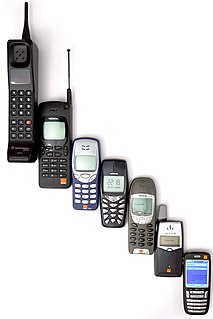 W
WA mobile phone, cellular phone, cell phone, cellphone, handphone, or hand phone, sometimes shortened to simply mobile, cell or just phone, is a portable telephone that can make and receive calls over a radio frequency link while the user is moving within a telephone service area. The radio frequency link establishes a connection to the switching systems of a mobile phone operator, which provides access to the public switched telephone network (PSTN). Modern mobile telephone services use a cellular network architecture and, therefore, mobile telephones are called cellular telephones or cell phones in North America. In addition to telephony, digital mobile phones (2G) support a variety of other services, such as text messaging, MMS, email, Internet access, short-range wireless communications, business applications, video games and digital photography. Mobile phones offering only those capabilities are known as feature phones; mobile phones which offer greatly advanced computing capabilities are referred to as smartphones.
 W
WNautel Ltd. is a Canadian manufacturer of AM and FM radio broadcast transmitters, navigational radio beacons, Differential Global Positioning System (DGPS) transmitters, NOAA weather radio transmitters, LF PNT/eLORAN transmitters, SONAR high-power low-frequency amplifiers and SONAR systems, medium frequency (MF) telegraph and NAVTEX transmitters, and high frequency (HF) amplifiers for dielectric heating applications. Nautel is best known as the first company to develop a commercially available fully solid state broadcast transmitter.
 W
WNHK Science & Technical Research Laboratories, headquartered in Setagaya, Tokyo, Japan, is responsible for technical research at NHK, Japan's public broadcaster.
 W
WOpenBroadcaster is a web-based, open-source system to run community radio and television broadcast transmitters with a simple web interface.
 W
WA personal radio service is any system that allows individual to operate radio transmitters and receivers for personal purposes with minimal or no special license or individual authorization. Personal radio services exist around the world and typically use light-weight walkie talkie portable radios. The power output, antenna size, and technical characteristics of the equipment are set by regulations in each country. Many regions have standardized personal radio service rules to allow travelers from one country to use their equipment in another country. Examples of standardized services include PMR446 and FM Citizens Band Radio (CB) in the EU and several other countries/regions. 26–27 MHz CB radio is the oldest personal radio service and is used in nearly every country worldwide, with many countries and regions copying the United States 40-channel frequency plan. In many countries, CB radio is less popular due to the availability of other personal radio services that offer shorter antennas, better protection from noise and interference.
 W
WIn electronics, a plate detector is a vacuum tube circuit in which an amplifying tube having a control grid is operated in a non-linear region of its grid voltage versus plate current transfer characteristic, usually near plate current cutoff, in order to demodulate an amplitude modulated carrier signal. This differs from the grid leak detector, which utilizes non-linearity of the grid voltage versus grid current characteristic for demodulation. It also differs from the diode detector, which is a two terminal device.
 W
WPMR446 is a licence exempt service in the UHF radio frequency band and is available for business and personal use in most countries throughout the European Union.
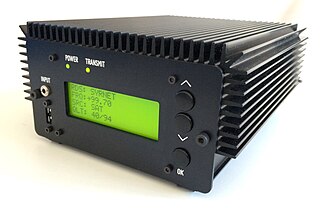 W
WPocket FM is a small, low-powered radio transmitter designed for use in areas with tightly controlled or undeveloped communications infrastructure. The devices are portable and have the appearance of a receiver rather than a transmitter, making them more practical for citizen use and harder for authorities to detect when used subversively in pirate radio networks. It was designed by German-based non-profit organization Media in Cooperation and Transition (MiCT) in 2013 and has been deployed in Syria to create the radio network called Syrnet.
 W
WProject Diana, named for the Roman moon goddess Diana, was an experimental project of the US Army Signal Corps in 1946 to bounce radar signals off the Moon and receive the reflected signals. This was the first experiment in radar astronomy and the first active attempt to probe another celestial body. It was the inspiration for later EME (Earth-Moon-Earth) communication techniques.
 W
WRadio frequency power transmission is the transmission of the output power of a transmitter to an antenna. When the antenna is not situated close to the transmitter, special transmission lines are required.
 W
WRadio-in-a-box (RIAB) is a portable, economical broadcasting system containing a laptop, mixer, CD/Cassette player, digital audio recorder, microphones and equipment needed to establish a radio station in remote or disaster locations.
 W
WThe radio spectrum scope was invented by Marcel Wallace - and measures and shows the magnitude of an input signal versus frequency within one or more radio bands - e.g. shortwave bands. A spectrum scope is normally a lot cheaper than a spectrum analyzer, because the aim is not high quality frequency resolution - nor high quality signal strength measurements.
 W
WA radio teleswitch is a device used in the United Kingdom primarily to allow electricity suppliers to switch large numbers of electricity meters between different tariff rates, by broadcasting an embedded signal in broadcast radio signals. Radio teleswitches are also used to switch on/off consumer appliances to make use of cheaper differential tariffs such as Economy 7.
 W
WRadio waves are a type of electromagnetic radiation with wavelengths in the electromagnetic spectrum longer than infrared light. Radio waves have frequencies as high as 300 gigahertz (GHz) to as low as 30 hertz (Hz). At 300 GHz, the corresponding wavelength is 1 mm ; at 30 Hz the corresponding wavelength is 10,000 km. Like all other electromagnetic waves, radio waves travel at the speed of light in vacuum. Radio waves are generated by charged particles undergoing acceleration, such as time-varying electric currents. Naturally occurring radio waves are emitted by lightning and astronomical objects.
 W
WA remote radio head (RRH), also called a remote radio unit (RRU) in wireless networks, is a remote radio transceiver that connects to an operator radio control panel via electrical or wireless interface. When used to describe aircraft radio cockpit radio systems, the control panel is often called the radio head.
 W
WThe Hohe Salve is a well-known mountain located between Kufstein, Wörgl and Kitzbühel in the Austrian state of Tyrol. It is part of the Kitzbühel Alps and is also nicknamed the Rigi of the Tyrol. Its summit is 1,828 m above sea level (AA) high, and in fine weather has a good view of the High Tauern and Zillertal Alps, as well as the Wilder Kaiser, which lies immediately to the north of the Hohe Salve. From the top the Großglockner and Großvenediger can also be made out.
 W
WSAM Broadcaster is an Internet radio broadcasting application by Spacial. The name "SAM" is an acronym for Streaming Audio Manager, which describes the software's functionality. The software features functionality for running an Internet radio station from a single computer. It can be used for running Live Shows with a DJ selecting the tracks to be played and mixing the sound as well as completely automated, where the programming is controlled by various rulesets outlined by the operator using PAL scripts to select tracks and queue shows.
 W
WA spectrum analyzer measures the magnitude of an input signal versus frequency within the full frequency range of the instrument. The primary use is to measure the power of the spectrum of known and unknown signals. The input signal that most common spectrum analyzers measure is electrical; however, spectral compositions of other signals, such as acoustic pressure waves and optical light waves, can be considered through the use of an appropriate transducer. Spectrum analyzers for other types of signals also exist, such as optical spectrum analyzers which use direct optical techniques such as a monochromator to make measurements.
 W
WA spurious emission is any radio frequency not deliberately created or transmitted, especially in a device which normally generates other frequencies. A harmonic or other signal outside a transmitter's assigned channel would be considered a spurious emission.
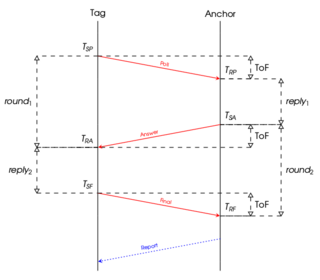 W
WIn radio technology, symmetrical double-sided two-way ranging (SDS-TWR) is a ranging method that uses two delays that naturally occur in signal transmission to determine the range between two stations:Signal propagation delay between two wireless devices Processing delay of acknowledgements within a wireless device
 W
WA television antenna is an antenna specifically designed for use with a television receiver (TV) to receive over-the-air broadcast television signals from a television station. Terrestrial television is broadcast on frequencies from about 47 to 250 MHz in the very high frequency (VHF) band, and 470 to 960 MHz in the ultra high frequency (UHF) band in different countries. Television antennas are manufactured in two different types: "indoor" antennas, to be located on top of or next to the television set, and "outdoor" antennas, mounted on a mast on top of the owner's house. They can also be mounted in a loft or attic, where the dry conditions and increased elevation are advantageous for reception and antenna longevity. Outdoor antennas are more expensive and difficult to install, but are necessary for adequate reception in fringe areas far from television stations. The most common types of indoor antennas are the dipole and loop antennas, and for outdoor antennas the yagi, log periodic, and for UHF channels the multi-bay reflective array antenna.
 W
WTraffic Message Channel (TMC) is a technology for delivering traffic and travel information to motor vehicle drivers. It is digitally coded using the ALERT C or TPEG protocol into RDS Type 8A groups carried via conventional FM radio broadcasts. It can also be transmitted on Digital Audio Broadcasting or satellite radio. TMC allows silent delivery of dynamic information suitable for reproduction or display in the user's language without interrupting audio broadcast services. Both public and commercial services are operational in many countries. When data is integrated directly into a navigation system, traffic information can be used in the system's route calculation.
 W
WA transmitter station or transmission facility is an installation used for transmitting radio frequency signals for wireless communication, broadcasting, microwave link, mobile telephone or other purposes.
 W
WTV radio, TV band radio, and TV audio radio are common names for a type of radio receiver that can play the audio portion of a TV channel. The actual name of the device may comprise a list of all frequency bands the device can receive, one or two of which includes the TV channel bands.
 W
WA wireless mesh network (WMN) is a communications network made up of radio nodes organized in a mesh topology. It can also be a form of wireless ad hoc network.
 W
WWireless USB is a short-range, high-bandwidth wireless radio communication protocol created by the Wireless USB Promoter Group which intends to further increase the availability of general USB-based technologies. In large, IPv6 was a key of this technology. It is maintained by the WiMedia Alliance and the current revision is 1.0, which was approved in 2005. Wireless USB is sometimes abbreviated as "WUSB", although the USB Implementers Forum discouraged this practice and instead prefers to call the technology Certified Wireless USB to distinguish it from the competing UWB standard.
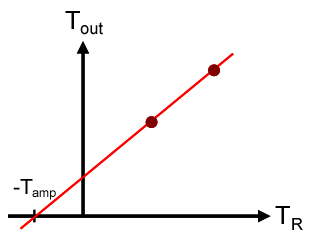 W
WThe Y-factor method is a widely used technique for measuring the gain and noise temperature of an amplifier. It is based on the Johnson–Nyquist noise of a resistor at two different, known temperatures.
 W
WZetron, Inc. is an American company that manufactures the mission-critical integrated communications systems. Founded in 1980, it is one of three subsidiary companies of JVCKenwood of Yokohama, Japan. It offers communications solutions for use by Emergency and Public Safety Agencies, Utilities and Transportation Companies.